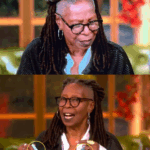For nearly three decades, ABC’s The View has captivated audiences with its unique blend of fiery debates, heartfelt confessions, and unpredictable drama. Love it or hate it, the show has become a cultural institution, sparking conversations far beyond the confines of daytime television. But what makes The View so irresistible? How has it managed to dominate the airwaves while other talk shows fade into obscurity?
The answer lies in a groundbreaking formula—a calculated mix of raw emotion, strategic conflict, and unfiltered vulnerability—that has turned The View into more than just a talk show. It’s an experience, a spectacle, and, for millions of viewers, an addiction.
:max_bytes(150000):strip_icc()/the-view-1-051625-ff3e5930b04749469fef8be19c27cc82.jpg)
The Birth of Chaos
When Barbara Walters launched The View in 1997, her vision was simple: a roundtable discussion featuring women from diverse backgrounds talking about current events. What she didn’t anticipate was how quickly the format would evolve into something far more volatile—and far more magnetic.
Unlike other daytime shows that prioritized harmony and light-hearted banter, The View embraced conflict. Producers realized early on that audiences weren’t just entertained by agreement; they were riveted by disagreement. Heated debates, emotional outbursts, and even on-air walkouts became staples of the show, creating a dynamic that was equal parts news discussion and reality television.
This willingness to lean into chaos set The View apart, laying the foundation for its secret formula: emotionally charged topics, paired with personalities guaranteed to clash, amplified by live vulnerability.
Emotion as the Driving Force
Every viral moment from The View—whether it’s a political showdown, a tearful personal revelation, or an explosive argument—fits into this formula. The emotion feels raw and spontaneous, and often it is, but the stage is carefully set for these moments to flourish.
Producers deliberately push boundaries, selecting topics that are emotionally charged and pairing them with hosts who hold opposing views. The result is a combustible environment where sparks are inevitable. One day it’s a debate over abortion rights; the next, it’s a celebrity scandal. Regardless of the subject, the show’s rhythm remains the same: raw human emotion, broadcast live.
This unpredictability keeps viewers hooked. Audiences never know if they’re about to witness a heartfelt confession or a fiery shouting match—and that uncertainty is addictive.
Why Other Shows Can’t Compete
Over the years, countless talk shows have tried to replicate The View’s success. From Oprah-inspired panels to celebrity-led discussions, none have managed to capture the same magic. Why? Because few networks are willing to gamble with volatility the way ABC has.
Most talk shows thrive on structure, scripting, and control. The View, by contrast, thrives on tension. The show’s producers allow genuine clashes between hosts, even if it means risking personal conflict or public backlash. This willingness to embrace unpredictability sets The View apart, creating a dynamic that feels both dangerous and real.
It’s the kind of drama that reality television has tried to perfect, but with the credibility of live news discussion.

The Cost of Chaos
Of course, the formula comes with its downsides. Over the years, The View has seen hosts quit on-air, public feuds spill into tabloids, and fans divided over controversial moments. Critics argue that the show promotes division rather than dialogue, turning important issues into spectacles.
But even detractors can’t look away. The drama, whether loved or hated, keeps people coming back.
For every viewer who swears off the show after a heated political clash, there are ten more who tune in the next day, eager to see what happens next. That emotional unpredictability, frustrating as it may be, is precisely what makes The View so addictive.
Addictive by Design
What makes The View truly unique isn’t just its content but its rhythm. By alternating between laughter, tears, and confrontation, the show mirrors the emotional highs and lows of real life. This rhythm creates a psychological loop—audiences crave the next emotional peak, whether it’s a shocking fight or a heartfelt confession.
It’s why fans who claim they’re “done” with the show often find themselves tuning back in. The emotional unpredictability is addictive, and that’s no accident.
The Untold Secret
After nearly 30 years, the truth behind The View’s success is clear: it’s not just a talk show. It’s a carefully crafted blueprint for addictive television.
Behind the laughter, the shouting matches, and the unforgettable walkouts lies a bold formula that combines unfiltered emotion, raw conflict, and authentic vulnerability. It’s messy, risky, and controversial—but it works.
Few shows dare to embrace chaos the way The View does. And that willingness to take risks—to push boundaries, spark debates, and showcase vulnerability—has made it a phenomenon that no other talk show has been able to replicate.
The Legacy of The View
As The View approaches its 30th anniversary, its legacy is undeniable. The show has not only redefined daytime television but also influenced how audiences engage with news, politics, and entertainment.
Whether you love it or hate it, one thing is certain: The View has tapped into something primal, something universal. It’s not just about the topics discussed or the hosts debating them—it’s about the raw emotion that connects us all.
And that, ultimately, is the untold secret of why millions can’t stop watching.
News
💔 “SHE DIDN’T PLAN TO BE A HERO — SHE JUST COULDN’T WALK AWAY.” 🌧️ When Rachel Maddow landed in Jamaica to cover the aftermath of Hurricane Melissa, she expected devastation. What she didn’t expect… was her. A little girl, barefoot in the wreckage, clutching a soaked teddy bear and whispering one word: “Mama.” Reporters looked away. Cameras kept rolling. But Maddow — silent, trembling — stepped forward. That night, she stayed. Days later, she signed the papers that changed both their lives forever. Now, as the world reacts to her unexpected act of love, one haunting question remains: Was this journalism… or destiny?|KF
1. The Storm That Took Everything The storm had no mercy. Hurricane Melissa tore through Jamaica with winds that howled…
😱 “NO CAMERAS. NO PRESS. JUST ACTION.” 💥 When Hurricane Melissa left Jamaica in ruins, everyone expected statements — not silence. But that night, Rep. Jasmine Crockett made a call no one knew about. Hours later, a private shipment — blankets, medicine, and water filters worth $500,000 — quietly left U.S. soil. No press release. No credit. Just a note inside the first box that made rescuers burst into tears. Now, the world wants to know: what did she write?|KF
When Hurricane Melissa finally loosened its grip on Jamaica, what remained was not silence but the faint hum of survival…
💥 “THE TAPES WERE NEVER MEANT TO LEAVE THE BUILDING.” 😳 A Turning Point USA insider has come forward — and what they just leaked about Erika Kirk and the Chief of Staff is sending shockwaves through conservative media. Behind closed doors, secret recordings. Late-night meetings. Deleted emails that someone thought were gone forever. And now, the story is unraveling — faster than anyone can contain it. The insider’s confession doesn’t just expose one scandal… it hints at a network of cover-ups stretching far beyond TPUSA. 👀 Either way, the receipts are coming — and they could change everything. 👉 Full leaked details in the comments (CMT) before they disappear… 🔥👇👇|KF
Late last night, an anonymous insider from Turning Point USA (TPUSA) dropped a bombshell that has sent shockwaves through conservative…
“LIVE MELTDOWN ON NATIONAL TV” — WHOOPI GOLDBERG’S EXPLOSIVE MOMENT LEAVES ‘THE VIEW’ IN CHAOS 😱💥 It started like any other morning at The View. Laughter. Headlines. Controlled chaos. Then — a single note changed everything. As producers slipped Whoopi Goldberg a message mid-segment, cameras caught something no one was supposed to see. With a glare sharper than a knife, she snatched the paper, ripped it to pieces, and tossed it aside — live, unedited, and on national television. The studio froze. Her co-hosts went silent. Viewers at home could feel it — that thick, electric tension pulsing through the screen|KF
Inside Whoopi Goldberg’s Live Meltdown — and the Crisis Shaking Disney’s Daytime Empire It started with a folded piece of…
💥 “NO CAMERAS. NO PRESS. JUST THREE NAMES THE WORLD THOUGHT THEY KNEW.” 🌪️ When the Category-5 monster Hurricane Melissa tore through Jamaica, help was nowhere in sight. Then — without a single announcement — a private jet touched down at dawn. Inside: Rachel Maddow. Stephen Colbert. Joy Reid. No sponsors. No cameras. No entourage. They brought 5 tons of food, medicine, water filters, and $1.5 million in aid, all paid from their own pockets. Locals said they worked through the night — lifting boxes, feeding children, treating wounds — not a single word about fame or press. And when a volunteer asked why they came, Joy Reid quietly answered: “Because the news doesn’t need to cover this — humanity does.” By morning, they were gone. No selfies. No headlines. Just whispers spreading across the island — “Were those really them?” Nobody knows who leaked the flight manifest. But one thing’s certain: this wasn’t charity. This was rebellion — against the silence of comfort. 🕯🌎 👇 Full uncovered story before it disappears…|KF
No cameras. No sponsors. Just three journalists who decided to act, not speak. When Hurricane Melissa struck Jamaica — the…
End of content
No more pages to load












